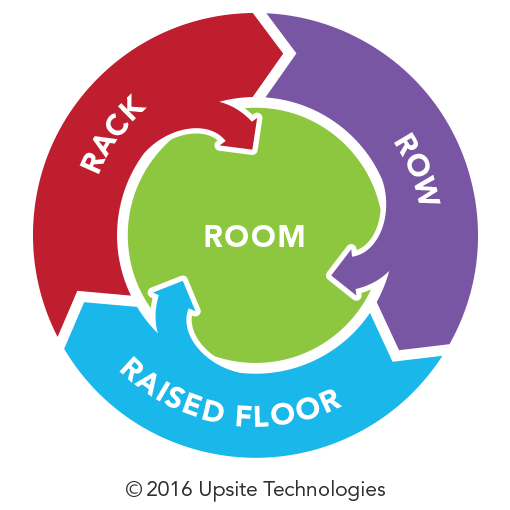Airflow Management Education
Examining the Science of Data Center Airflow Management.
Pioneering Airflow Management
Known as the pioneers of airflow management, Upsite Technologies offers a wide array of industry-leading solutions which properly manage airflow and optimize data center cooling. Airflow management is an essential concept because it is the first step to reducing operating costs and energy consumption in a data center. By implementing airflow management solutions such as grommets, blanking panels, containment, and other initiatives, it allows you to raise temperature set points, turn off cooling units, and reduce fan speeds, which in return reduces energy consumption and operating expenses. We recommend using our 4 Rs methodology when implementing airflow management solutions to see the best benefits. Our 4 Rs methodology is a unique guide to ensure the optimal outcome of airflow management initiatives by applying in this proper sequence: Raised Floor/Rack, Row, and Room (explained below).
The 4 R’s of Airflow Management™
With so many variables affecting airflow within a data center, it can be daunting to know where to start and how to get the most out of airflow management improvements. Upsite’s 4 R’s of Airflow Management™ is a holistic methodology for implementing changes to optimize the data center’s cooling infrastructure and realize energy savings, including the Raised Floor, the Rack, the Row, and the Room. We used CFD analysis to model a 4,000 sq. Ft. data center and provide engineering simulation to assess the impact of the changes made at each level.
The execution of the steps resulted in:
- Reduction in the maximum IT inlet temperature of 8.4° F
- A cooling supply temperature increase of 10° F
- Cooling unit fan speeds reduced by 35% and one cooling unit turned off
- Partial PUE (pPUE) decreased from 1.54 to 1.34
- Over $60,000 in annual savings for a 4,000 Sq. Ft. Data Center
- 15 month ROI
Airflow Management Methodology
Raised Floor: Manage the open area of the horizontal plane of the raised floor. Seal cable openings with grommets and brushes, and manage perforated tile placement. Check the perimeter walls below the raised floor for unsealed wall or partition penetrations. Sealing these penetrations requires fire-rated materials. (See Products)
Rack: Close all open space of the vertical plane of IT equipment intakes. Install blanking panels and rack grommets, seal under cabinets, and seal between mounting rails and sides of cabinets. (See Products)
Row: Block open spaces underneath racks, where IT equipment cabinets are missing, and where there are gaps between cabinets. In situations when cabinet densities are high enough, or the highest possible efficiency is desired, hot or cold aisle containment is necessary. (See Products)
Room: Change the cooling infrastructure by raising cooling-unit, return air temperature set points. Raise set points as high as possible without exceeding the IT equipment intake-air-temperature maximum. Turn off cooling units or reduce fan speeds for units with variable frequency drives (VFD) or install VFDs. Monitor cooling efficiency and make adjustments as needed. (See Services)

Bypass Airflow Clarified
Bypass airflow is a term coined by Upsite Technologies, which refers to any conditioned air supplied by a cooling unit that does not pass through (bypasses) IT equipment before returning to a cooling unit. Two leading causes of bypass airflow are openings in the raised floor and excessive volumes of cold air in a cold aisle. By reducing bypass airflow, you could see many benefits such as increased cooling unit efficiency and capacity, reduced operating expenses, and improved IT equipment reliability.
Reducing Bypass Airflow Is Essential for Eliminating Computer Room Hotspots
Reducing bypass airflow requires placing perforated tiles only in the cold aisles, closing unmanaged openings, and other significant, but relatively inexpensive changes in computer room layout and operating practices.
Cooling Capacity Factor
Cooling Capacity Factor (CCF) is a metric developed by Upsite Technologies to determine the cooling effectiveness of a data center. The CCF measures the cooling output relative to the IT load, providing an accurate picture of cooling infrastructure efficiency. It can be calculated by dividing the total rated cooling capacity of the running cooling units in the computer room (kW) by 110% of the IT critical load (kW). After benchmarking your room’s existing CCF, you can take steps to make improvements.






